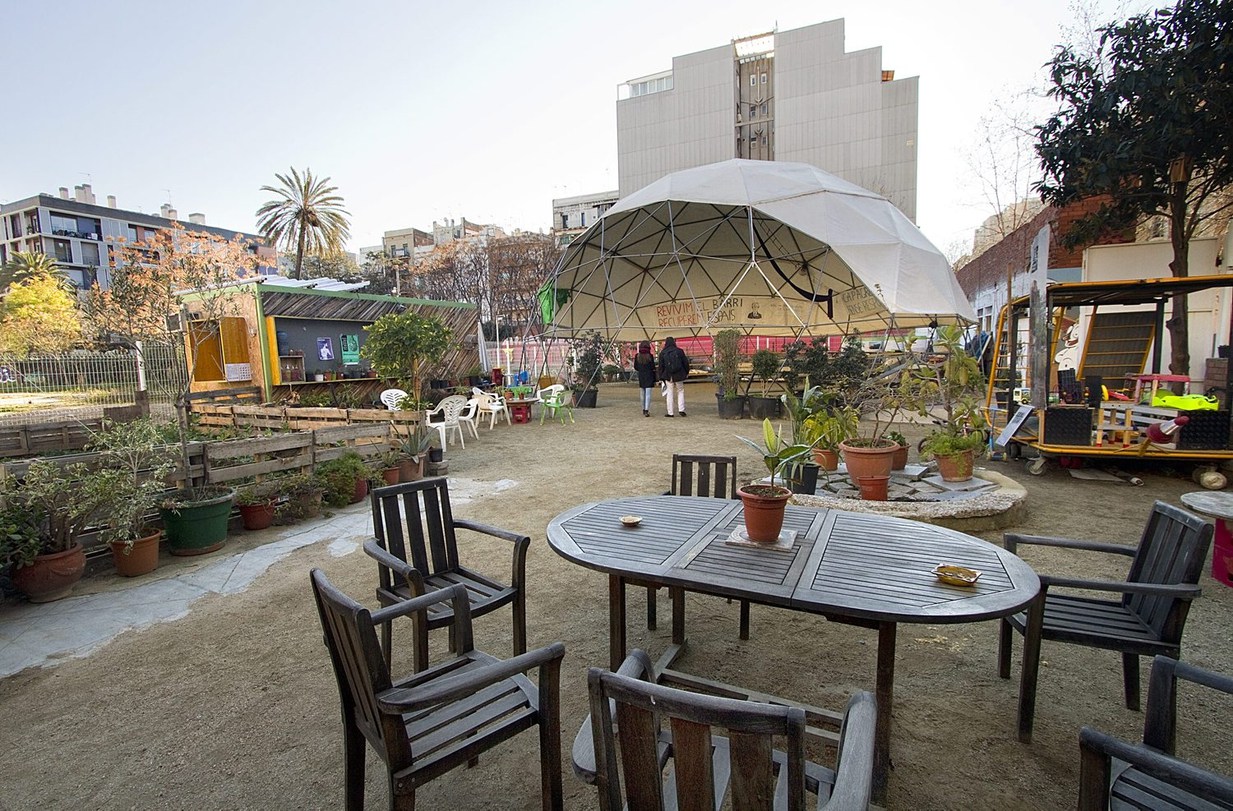| This participation project was born in the Esquerra Eixample Assembly that arises from the Occupy 15M/Indignados movement (2011) and has the institutional support of the local Neighborhood Association (Esquerra de l'Eixample) and technical advice from various entities such as Straddle3, Idensitat, Cami Amic, Ateneu l'Entrebanc, IntraScapeLab, CST, Makea, Raons Públiques or Encajes Urbanos, among others.

Germanetes is part of a municipal lot of 5500 m2 intended for equipment, abandoned since 2004, amid the Eixample Quarter. Specifically in the block between the streets Consell de Cent, Compte Borrell and Viladomat. The aim of the project from its inception, has been the reappropriation of empty and unproductive spaces to turn them into public community spaces; and to promote pacification of the streets adjacent to the lot.
In October 2011, during the neighborhood Festival, an open mapping workshop in which residents showed an axis of equipment on the street Borrell, articulated around schools and Cami Amic Association was promoted; little green quality public space; and a large space into disuse. Fruit of discovery arose to work for the reappropriation of solar Germanetes and Recreant Cruïlles (Figure 1) was formed. The group saw at the urban void the opportunity to develop a new, more responsive to citizen participation and urban social model and avoid environmental impacts.
A broad-based participatory process was promoted to open and exploit the solar self-managed so as promised municipal facilities were not built. For maximum diffusion, worked on a double line. On the one hand programming protest to the streets (Workshop Idensitat Device In / Out (2) Action Photoblog Mural with Inside / Out (Figure 3), among others) festivities, culminating with paellas to get the popular eco necessary in the administration. And, secondly, the development of a solid draft consensus. Thus, 4 deliberative workshops were held in the Civic Center Golferichs where he worked in format open participatory process on the issue of space and future alternative uses (Figures 4 and 5). In parallel profitable alliances were woven with groups of architects as Straddle3, which subsequently provided much of the infrastructure of space; or collective of artists like Idensitat with a series of symbolic intervention projects in space with the neighborhood through project collaboration Devices Post (Figure 6) was developed.
In March 2012 the City Council presented the notice of Pla BUITs. A contest that promoted the transfer of solar municipal entities and nonprofit organizations to develop temporary activities. The call was perceived as an opportunity, a Trojan horse that allowed into the floor without cease their industrial action in public space.
Finally, in November 2013, two years after the start of the neighborhood claim, he entered the solar, with the support of the AVVEE as institutional representative. This new phase was marked by several days of collaborative work for the construction of two devices (dome and container), in which Straddle3 guided and provided the basic infrastructure for the start of the activity (Figure 7). The assembly of a store taking advantage of a container clad woodwork to give it a softer appearance; and a large geodesic dome steel concentric tiers. Possibly the most clear and convincing a space that gives the opportunity to hear and be heard expression. A very suitable to the assembly and the representation space. In parallel, a working group for the construction of an orchard claiming the green space was created.
In early 2014, three years after the first actions as a collective and one year after the start of the activity, Germanetes has become a small outdoor civic center where free workshops and classes are held daily. A new social space in a densely populated neighborhood (Figure 8). A critical focus among other thought, promotes new ways to consume through monthly Markets close. And finally, the visibility of the site, has spurred the construction of some facilities historically claimed (Institute Day Centre, Cradle School). Despite having achieved some of the initial objectives, the initiative continues to work to get the pedestrianization of the streets adjacent to the site to weave a pacified with a square at each crossing network.
Germanetes not only forms an urban space, but a human space, in which the way of doing things is as important as the projects themselves. Therefore, the constant harmony between the demands and neighborhood needs is key in the design process.
|
